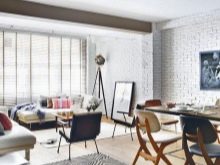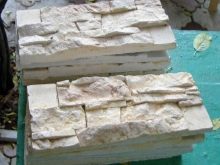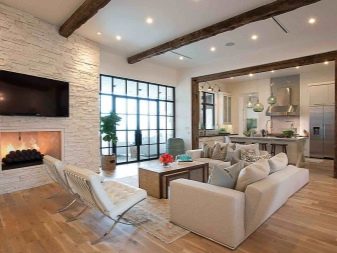Brick-like gypsum tiles: advantages and design options

Gone are the days when the unpleasant reddish-orange brickwork was plastered and hidden behind wallpaper or sewn up with plastic. Brick has rightfully taken its place in the interior design of hallways and bathrooms, residential and office premises. The premises, designed in this way, have an element of romance and charm, while being an object of ultra-modern style.
Peculiarities
Not every apartment can accommodate an additional brick row - nowadays buildings are built of metal and concrete, wooden and frame structures have become the norm. Not every structure can withstand heavy brickwork. But you shouldn't give up such a spectacular design option. An alternative can be brick-like gypsum tiles.
She, like any other material, has certain pros and cons, the knowledge of which will help to make the right choice.


Advantages:
- Security. Gypsum is a material of natural origin, therefore, products based on it are environmentally friendly.
- Durability. Compared to many other finishes, it is more durable and lasts its entire life. Often used in places most prone to abrasion and mechanical stress.
- Thermal insulation. Due to its low thermal conductivity, it retains heat inside the room, preventing the cold from penetrating outside. A wall covered with such material will never freeze.
- Noise isolation. The density of the material is high, the sound permeability is low, therefore, the penetration of noise is minimized.
- Fire resistance. Withstands the combustion temperature of a direct flame, can be used for direct cladding of stoves and fireplaces. When heated, it does not emit any hazardous substances.


- Maintaining a comfortable indoor climate. Absorbs excess moisture from the air, gives it away in case of excessive dryness, evens out the temperature of the surrounding space.
- The ability to create a realistic texture, highlight accents, emphasize the dynamism of the interior.
- The weight. Gluing can be carried out on any wall without reinforcement using almost any glue, does not carry a global load on the floor.
- Ease of installation and processing. You can start work with absolutely no experience.
- There is no need to purchase additional equipment or special materials.
- Price. The price / quality ratio is perfect. The price of the material is low, moreover, there is the possibility of its own production.


Disadvantages:
- More suited for indoor than outdoor use.
- Excessive hygroscopicity is a contraindication to the placement of material in outdoor decoration, however, today the production of a gypsum-cement board has been launched, which is quite suitable for exterior decoration.
- Increased fragility. This indicator can be reduced by adding special substances at the manufacturing stage and processing the surface with them after installation.
- Difficulty in leaving. Untreated gypsum surfaces tend to accumulate dust.
- When the tile is placed in a room subject to high humidity, it is necessary to treat it with additional protective and water-repellent solutions.


Colors
Natural plaster color is white. Initially, the color of the finished product is the same.But in the manufacturing process, it is possible to add coloring pigments of any shade to the mixture. The finished product will be uniformly colored and fade resistant. In case of chips and cuts, the cut of the bricks on the inside will have the same color as on the outside.
Also, it is obtained to paint gypsum tiles during processing with its compositions from fragility. They contain vitriol, which is a dye. Copper sulfate gives a bluish tint, and iron sulfate gives a yellowish tint.
You can also paint it yourself in any color, increasing the adaptability of the tile to any interior.


How to choose?
For street decoration, this finishing option will be unacceptable. For the external decor, a similar material was invented - gypsum-cement tiles, visually indistinguishable from gypsum tiles. Therefore, having set out to improve the exterior of the home, take the trouble to find out about the composition of finishing materials in more detail.
Materials imitating bricks are used more and more often for interior decoration of premises. The masonry goes well with many styles, and due to the variety of colors and textures, the question of choosing a specific finishing material arises.
If your room is made in the loft style, then a large space should be occupied with bricks, at least one wall. The color should be as close as possible to the color of natural brick - all kinds of shades of the ocher-red spectrum. The size of the bricks is selected to be approximately 6 by 12 centimeters.


The romance of village life is best emphasized by the combination of brick and wood. A brick wall could be painted to imitate lime over textured bricks.
Brick goes well with the Gothic style - wrought iron elements and massive furniture, stained-glass windows and a fireplace. Decorative plaster and crystal chandeliers will also harmoniously fit into such an interior.
Minimalism is characterized by large masonry areas and a minimum of details. Bright color accents are encouraged.



A decorative texture reminiscent of a brick is a worthy alternative to textured wallpaper with a "brick effect", decorative plaster, drywall, real bricks, and their facing options.
There is a possibility of making tiles with your own hands. For this, you will need a gypsum mixture, a silicone mold, a flat surface, colors, matte acrylic varnish, brushes and a spatula. If you follow all the recommendations for the manufacture of the product, there will never be any problems with choosing the fragment of masonry you are interested in.



How to stack correctly?
Plaster tiles are quite unpretentious. Suitable for laying it are metal, wood, concrete surfaces, as well as old brickwork.
When working with concrete or brick, you need to keep in mind the porosity of the texture. If there is such a need, they should be treated with a special primer mixture.
If you have to design a less solid object, finished with plasterboard, OSB-board or plywood board, you need to make sure that these surfaces are able to maintain their shape. Fastening the plaster decor to drywall should begin after checking it for dryness.
Working with wood involves attaching a fiberglass to it, which must be plastered. There are two methods of fixing plaster tiles: dry (fasteners are used) and wet.


Regardless of the method chosen, there is a set of preparatory measures that are fundamental:
- Leveling the surface.
- Cleansing from excess substances or contaminants using a soapy solution, after which the surfaces will need to be thoroughly dried.
- Now you can directly deal with the manipulation of facing bricks - they should be sorted, excluded defective or broken specimens, spread out for ease of fastening.



Dry styling:
- Make sure the fasteners have side fastening slots.
- Wall markings. A distance equal to the length of one tile is set off from any corner of the wall or furniture. The rail is mounted vertically.
- Tiles are collected from top to bottom into the resulting "tunnel".
- The decor is fixed using special bolts.
- Re-putting the length of the given element next to it.


Wet way:
- Determine by what method the bricks will be placed - in the joint or by expanding the seams.
- Layout of rows directly on the treated area and preliminary laying out of tiles before fixing them to the wall. We must not forget about the thickness of the future seam, if it was decided to provide for it.
- Prepare a small portion of the adhesive solution, remembering that it begins to set after thirty minutes.
- Work must be done in the direction from bottom to top, starting from the bottom corner.
- The adhesive is applied directly to the tiles or to the working area with a thickness of no more than 2 mm.
- The gypsum blank is pressed into the wall with a rotating motion very carefully.




Can you paint?
Plaster tiles with the effect of a natural stone or brick surface are sold in stores everywhere. The most common factory staining method is bulk staining. For this, tinting pigments are added directly during the mixing of the plaster mass. This method is most effective, since when chipped, the products will have a natural texture color, not only outside, but also inside.



From a huge number of colors and shades dazzles in the eyes, but upon closer examination, all the flaws of industrial coloring become visible - the tinting is often far from natural and cuts the eye with strange color accents.

Coloring the finished product seems to be not a complicated matter, however, the success of the entire design project depends on the visual perception. If you set out to bring an element of liveliness to the factory painting and are doing it for the first time, then it is worth treating each detail separately even before attaching it to the wall. Subsequently, upon receipt of the initial experience, one can proceed to the mass coloring of the gypsum cloth already fixed on the object.


There are several simple and time-tested methods of painting:
- Add a glass of water and acrylic primer to half a teaspoon of paint. Accent spots are applied directly to the bottom of the mold before pouring the solution. This method requires high-quality drying, after which the workpiece is covered with a matte water-based varnish.
- Tinting paste is added to the water and applied to the untreated plaster surface with a brush, airbrush or simple household spray gun. Due to its hygroscopicity, gypsum will absorb paint and, after drying, will take on a completely lively appearance. You can replace up to half of the water in the solution with an acrylic primer, from which the dried tiles will gain additional strength.
If, after tinting, the color becomes too pale, it can be restored to its natural color by applying a matte or silky matt varnish. This will give the product extra strength.


Examples in the interior
Designers all over the world are delighted with the prevailing trend to introduce such an element of decor as a brick wall into the interior of residential apartments, office premises and public institutions. It can be used both in a brutal fireplace room and in a romantic bedroom.
A brick wall can be a great alternative to wallpaper, panels and plaster because it looks more intriguing. The cost of a material that imitates a real brick is minimal, and the possibilities are almost endless:
- Hallway. Most often, in conditions of limited space in the hallway under a brick, it is customary to decorate only one wall. The light tone of the bricks will not hide the space.Another option is to decorate with masonry a frame for a mirror, an arch, a place for clothes.


- Living room. The brick wall will be the perfect backdrop for creating a video area. It is also perfect for creating a contrasting interior: a dark shade of masonry - light furniture, and vice versa. Even if the accent brick wall is painted in the same color shades as the rest of the space, it will attract everyone's attention with its texture. If the interior of the hall is supplemented not only with a brick wall, but also with massive wooden ceiling beams and columns, filled with wrought iron objects and crystal chandeliers or sconces, then it will be possible to bring the spirit of a medieval castle into a modern dwelling.
If there is a fireplace in such a space, you can decorate with plaster bricks not only its firebox and facade, but also the space near and above it.




- Bedroom. The calmness of the bed will in no way be disturbed by the brick wall behind the head of the bed, but it will look stunning.
- Children's. In a children's room, bricks can be used as zoning.




- Bathroom. Combined with snow-white sanitary ware, the brick texture provides an interesting contrast.



- Kitchen and dining room.
- Masonry as a kitchen backsplash.
- Zoning of the dining area.
- Contrast with monotonous kitchen surfaces and facades.




- Office and cabinet
- A cafe





How to make an imitation of a brick wall from plaster tiles, see below.













The comment was sent successfully.